Traffic Incident Management (TIM) Gap Analysis Outreach Briefing – Executive Decision Makers
Printable Version [PDF, 1.9 MB]
You may need the Adobe® Reader® to view the PDFs on this page.
PowerPoint Version [PPT 3.01 MB] – The PowerPoint Version contains the speaker notes.
PPT files can be viewed with the Microsoft PowerPoint Viewer.
Contact Information: Operations Feedback at OperationsFeedback@dot.gov
 slide 1
slide 1
Traffic Incident Management (TIM) Gap Analysis Outreach Briefing -
TIM Executice Decision Makers
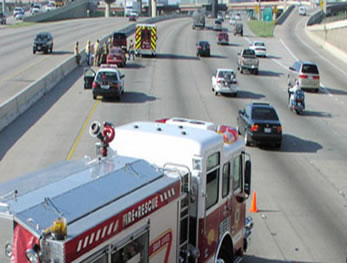
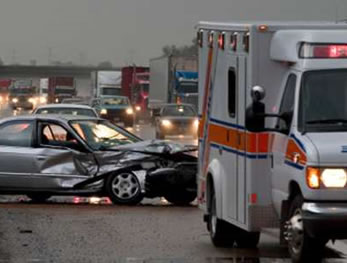
Photo credits: FHWA

slide notes
Make introductory remarks about:
- The presentation format.
- The project – to identify gaps in the current national state of the practice and recommend actions for addressing those gaps.
- The fact that this presentation is directed at executive managers. Executive managers need to understand the importance and benefits of TIM as their support is essential to an effective TIM program.
 slide 2
slide 2
Outline
- Briefing Objective and Overview
- Primer Objectives and Outline
- TIM Gap Analysis
- Successful TIM Program
- Implementation Strategies and Action Plan
slide notes
This slide outlines the format for today’s presentation:
- Briefing Objective and Overview
- Primer Objectives and Outline
- TIM Gap Analysis
- Successful TIM Program
- Implementation Strategies and Action Plan
Each item will be addressed in detail during the presentation.
Indicate that at the end of the presentation and at the end of the document, the goal is that you have very targeted information to help you as you seek to establish a TIM Program and Action Plan.
 slide 3
slide 3
Briefing Objective and Overview
slide notes
As this is a transition slide, you may wish to say “the first element is the objective of the briefing and an overview” and then quickly advance to the detailed slides.
 slide 4
slide 4
Briefing Objective
slide notes
Use this slide to emphasize that a successful TIM program needs leadership and support from executive management.
Key elements of this are:
- Commitment to organization, staff and funding as available
- Commitment to support for TIM policies that identify needed actions
- Commitment to demonstrating program leadership at the executive management level
- Commitment to engaging outside agencies at the executive management level
At the end of the presentation – and more importantly, in the document – you will have a better idea of how best to design, operate, and maintain a sustainable traffic incident management program.
 slide 5
slide 5
Overview of Traffic Incident Management (TIM)
- Timeline of Stages in the TIM Process:

Source: FHWA Traffic Incident Management Handbook 2010
|
National Averages |
|
Roadway Clearance Time |
Incident Clearance Time |
| 2012 |
70.29 min. |
55.66 min. |
| 2013 |
68.90 min. |
56.34 min. |
Source: 2013 FHWA Traffic Incident Management Self-Assessment Executive Summary
slide notes
This timeline shows the timeline and on the right, the national averages. If you know, note where your TIM program fits with regard to this timeline.
- This slide shows the various stages of an incident.
- It is important for executive managers to understand at this high level the complexities of incident response and the manner in which their agency can support the response.
- Incident duration varies by a number of factors including severity and response time and capabilities.
- In the annual evaluation of its Coordinated Highways Action Response Team (CHART) program, the State of Maryland estimated that the CHART-directed incident management resulted in average incident duration of 22 minutes, as compared to 29 minutes for other agencies.
 slide 6
slide 6
Overview of Traffic Incident Management (TIM)
slide notes
- All effective programs include active involvement and coordination with multi-disciplinary stakeholder agencies, including the public and private sector.
- No one agency can develop and implement a comprehensive TIM program alone. All effective programs include active involvement and coordination with multi-disciplinary stakeholder agencies, including the public and private sector.
- Improved TIM has been shown to reduce both overall incident duration as well as secondary crashes.
- In the annual evaluation of its Coordinated Highways Action Response Team (CHART) program, the State of Maryland estimated that the CHART-directed incident management resulted in average incident duration of 22 minutes, as compared to 29 minutes for other agencies, and that this reduction in incident duration resulted in 290 fewer secondary incidents in 2005.
- The impact of this reduction incident duration is demonstrated by a study published in the ITS Journal that estimated that the likelihood of a secondary crash increases by 2.8 percent for every minute that the primary incident remains a hazard.
 slide 7
slide 7
Impact of Incidents
- Account for about 25% of all non-recurring congestion
- Significant threat to life safety and influence travel time, economic productivity, and transportation system performance
- Requires proactive planning to achieve quick incident clearance
slide notes
Benefits of TIM – you can choose to highlight a few as desired:
- 160+ law enforcement officers struck and killed by a vehicle since 2000 (and this number is higher by 2012). Source: National law enforcement database, 2010
- 2.8 billion gallons of fuel wasted annually by Americans idling…Source: Cambridge Systematics, Inc. 2011. Crashes vs. Congestion: What’s the Cost to Society? Bethesda, MD: AAA Foundation.
- 4 minutes added to traffic delay for every minute a lane is blocked. Source: Oregon DOT, 2012 (and they estimate 4-6, so this is conservative!)
- 36 hours are wasted every year sitting in traffic queues by the average American. Source: U.S. DOT Strategic Plan FY 2010 – FY2015; April 15, 2010
- 85% jump in incident related costs… Source: AAA, 2012
- 38,000 responders are in harm’s way…. Source: Emergency Responder Institute. Estimate based on number of injury crashes per minute; and typical number of emergency responders to injury crashes. This number is conservative and actually much higher as non-injury crashes also require response, as do fatal crashes
- An estimated three injury crashes occur every minute. This translates to 1,620 responders working in or near moving traffic every hour or 38,880 responders potentially in harm’s way in a 24-hour period based on a typical response. A typical response might include: two law enforcement responders, four fire department responders, two EMS responders, and one tow truck operator, for a total of nine responders.
 slide 8
slide 8
Overview of TIM Stakeholder Involvement
| Traditional Responders |
Special/Extreme Circumstance Responders |
Incident Information Providers |
Transportation System Providers and Users |
- Law Enforcement
- Fire and Rescue
- Emergency Medical Services (EMS)
- Towing and Recovery
- Transportation Agencies
|
- HazMat Contractors
- Coroners and Medical Examiners
- Emergency Management Agencies
- Environmental/ Natural Resources/ Departments of Health (DOH)
- Utilities
|
- Public Safety Communications
- Traffic Media
- Traveler Information Services
- Transportation Agencies
|
- Traveling Public
- Trucking Industry
- Insurance Industry
- Public Transportation Providers
- Motorist Organizations
|
Source: FHWA Traffic Incident Management Handbook 2010
slide notes
- This slides shows the range of stakeholders that need to be engaged to make a well-organized, multi-discipline TIM program successful.
- As decision makers, your support and proactive leadership is critical in the engaging of the various stakeholders.
- It has been shown that the most effective TIM programs put a significant effort into the development, signing and maintenance of MOUs. Management support of this activity is critical.
 slide 9
slide 9
Primer Objectives and Outline
slide notes
This is a transition slide. You may wish to say “next we will discuss the objectives of the primer and outline its content”.
 slide 10
slide 10
Statement of the Problem
Policies and operating procedures for TIM programs not only vary from state to state, but vary regionally within each state and between rural, suburban, and urban areas
slide notes
The problem:
- Many of the nation’s TIM programs lack a robust, full-scale, comprehensive approach that includes all aspects of incident management with long-term vision and objectives.
- While there are a number of very comprehensive and successful TIM programs across the country, their lessons learned and best practices need to be extended to create more consistent incident management on a wider scale.
 slide 11
slide 11
Primer Objectives
- Identify and summarize the current state of TIM practice and activities
- Identify and summarize gaps found in TIM activities/information
- Identify and outline a framework for achieving a complete TIM program utilizing national guidelines
- Outline the key elements that are contained in successful TIM programs
slide notes
Here’s what a decision maker need to know (versus what does a technical person need to know) about the objectives vis a vis what they influence can in the TIM program.
- Identify the “general” objectives and indicate that this presentation will focus on presenting the material in a way that focuses on the roles of executive managers.
- Details will be provided in the material that follows.
 slide 12
slide 12
Primer Organization
- Introduction
- TIM Gap Analysis Summary
- Components of Successful TIM Program
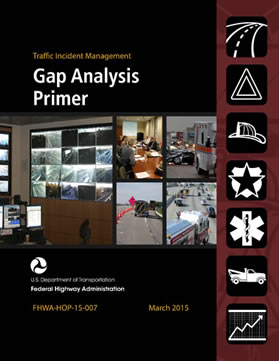
slide notes
Note the role of decision makers and a successful TIM program.
You can “read” the bullets as a summary of the organization of the primer – and indicate that the roles of decision makers will be discussed in the content
 slide 13
slide 13
Primer Organization
- Roles and Responsibilities of TIM Stakeholders
- TIM Program with Transportation Operations Program
- Conclusions and Recommendations

slide notes
Note the specific roles and responsibilities of the decision makers.
Read the bullets as a summary of the organization of the primer – and indicate that the roles of decision makers will be discussed in the content.
 slide 14
slide 14
TIM Gap Analysis
slide notes
As this is a transition slide, may wish to say “and now we will discuss the gaps that were identified in the national TIM program analysis” and then quickly advance to the detailed slides.
 slide 15
slide 15
TIM Gap Analysis
- Inventory of institutional, technical, and financial capabilities of current TIM programs at different government levels
- Two-tier Analysis
- Federal and National
- State and Local
slide notes
The speaker can discuss the two tiers:
- The success of the TIM practice at any of the state/local level programs depends mainly on the active involvement and coordination between the different TIM partners.
- Slide #8 identified key agencies involved including Law Enforcement, Fire and Rescue. EMS, Towing and Recovery and Transportation Agencies. Examples of the state/local level TIM activities include conducting TIM committee meetings, multidisciplinary trainings, tracking of targeted performance goals, developing and promoting TIM procedures and policies, coordinating the available TIM resources including equipment and data, and successful incident scene interagency collaboration.
- On the national level, government and non-governmental agencies and coalitions contribute to the development and success of the TIM practice at both the policy and operations levels. A key role of the national TIM agencies is to provide support to the state/local level TIM programs to enhance and advance their TIM practices. Examples of the national TIM-involved agencies include FHWA Office of Operations’ Traffic Incident & Events Management (TI&EM) team, International Association of Chiefs of Police (IACP), International Association of Fire Chiefs (IACF), Towing and Recovery Association of America (TRAA), and the U.S. Fire Administration (USFA).
- This approach provides agencies at all levels with insight into their gaps and actions needed to address the gaps.
 slide 16
slide 16
Current TIM Gaps
- Represent focus areas for national level TIM agencies in order to most effectively support state/local programs in achieving their TIM goals
- Examples of Program/Institutional Gaps:
- Multiagency involvement from all TIM partners
- Formal documentation of the TIM agreements (e.g., MOUs)
- Multidisciplinary TIM training
slide notes
Indicate that the Program/Institutional gaps are some of the most critical to executive managers as they relate to matters of policy, organization and inter-agency coordination. Executive management support is often required for these issues to be addressed.
Other examples of Program/Institutional Gaps include
- PM and goals tracking
- Road clearance laws and legislations
- Public awareness and outreach
The Traffic Incident Management Self-Assessment (TIM SA) was developed by the Federal Highway Administration (FHWA) as a benchmarking tool to evaluate TIM program components and overall TIM program success. The 2011 Self-assessment had more than 90 responses and included a comparison to a baseline derived from previous self-assessments.
In their 2011 Incident Management National Analysis Report, USDOT found that:
- The establishment and use of TIM performance measures consistently ranked low. The ability to track reduction in secondary accidents was ranked lowest, almost half of respondents indicated no activity in this area.
- Another area with low scores was multi-agency coordination – in particular defining agency roles for planning and funding TIM as well as regularly updating TIM related agreements.
 slide 17
slide 17
Current TIM Gaps
- Examples of Operational Gaps:
- Responder safety procedures and practices
- Equipment staging and scene management
- Accident reconstruction and investigations
- Examples of Communication/Technology Gaps:
- Emergency communications systems during incident response
- Prompt incident detection and notification
slide notes
Note that operational and technology gaps are often more focused on by the staff and lower level managers but executive management support is needed to enable the staffing and resources that can be focused on these issues.
Other examples of Operational Gaps include
- 24/7 responder availability
- Safety service patrol (SSP) availability
Other examples of Communication/Technology Gaps include
- Interoperable data sharing
 slide 18
slide 18
TIM Gap Analysis Results
slide notes
Indicate that the role of TIM agencies and efforts at the national level is at a policy level aimed at supporting the implementation of effective TIM training and practices at the state/local level.
 slide 19
slide 19
TIM Gap Analysis Results
- The ability to efficiently achieve the 18 strategies of the National Unified Goal (NUG), represents the key framework for a successful complete TIM program
- Cross-Cutting Strategies
- Responder Safety
- Safe, Quick Clearance
- Prompt, reliable Incident Communications
slide notes
This explains what the NUG is and what it means for a TIM program. As a decision maker, it’s more than likely that he/she has never heard of the NUG.
The National Unified Goal (NUG) for Traffic Incident Management is a unified national policy developed by major national organizations representing traffic incident responders, under the leadership of the NTIMC.
The Traffic Incident Management National Unified Goal is directed at improving:
- Responder safety;
- Safe, quick clearance; and
- Prompt, reliable, interoperable communications
The three major objectives of the National Unified Goal will be achieved through 18 strategies including recommended practices for multidisciplinary TIM operations and communications; multidisciplinary TIM training; goals for performance and progress; promotion of beneficial technologies; and partnerships to promote driver awareness.
 slide 20
slide 20
The Nation Unified Goal (NUG) Gap Analysis Framework
- Document the identified challenges and barriers (i.e. gaps) in the current TIM practice
- Develop a means to bridge these challenges and barriers
- Propose the components of a complete TIM program
slide notes
The Gap Analysis was accomplished via a comprehensive literature search directed at determining the current state of the practice as well as best practices.
A framework was then created based on the National Unified Goal to document the elements of current TIM programs, identify gaps and barriers and recommend strategies to address the gaps/barriers.
 slide 21
slide 21
The NUG Gap Analysis Framework (Examples)
| National Unified Goal (NUG) Strategy |
Key Elements |
Challenges & Barriers |
Strategies to Overcome Challenges & Barriers |
| TIM Partnerships and Programs |
Synchronized TIM programs at the state, multistate, regional, and local levels |
Departments of Transportation (DOTs) often are not included in emergency planning and preparedness organizations’ activities |
Agency executive/senior leader engagement and buy-in |
| Multidisciplinary NIMS and TIM Training |
Cross training of the incident scene roles and responsibilities |
Volunteer agencies do not have the same time available for training that full-time agencies have |
Availability of multidisciplinary TIM training courses and delivery processes appropriate for full-time and volunteer agencies |
| Goals for Performance and Progress |
Having a systematic approach for measuring TIM program performance across national and state/local levels. |
Performance metrics vary across agencies, making it difficult to compare results |
Development of performance measures (PM) and data collection methods including those for each stage of an incident |
| TIM Technology |
Sustainable and interoperable ITS technologies for TIM |
Consistent use of existing technologies by all disciplines |
Establishment and implementation of standard and efficient use of technology |
| Effective TIM Policies |
Formal strategic plans and written interagency operational policies. |
Lack of interagency coordination at all levels including the senior executive level. |
TIM Task Force representatives with information to educate their agencies, senior leaders. |
| Awareness and Education Partnerships |
Develop partnerships to educate responders and motorists on responsibilities of the safe, quick clearance of incidents. |
Lack of awareness and education regarding the public’s role. |
Identification of the best ways of getting information out to the public. |
slide notes
Full table can be accessed in the main primer document in pages 12-16.
Briefly discuss the overall content and approach at a high level and then discuss one key row and an example:
This is an example in which executive management support is important
NUG Strategy: TIM Partnerships and Programs.
Key Elements: Synchronized TIM programs at the state, multistate, regional, and local levels.
Challenges & Barriers: Departments of Transportation (DOTs) often are not included in emergency planning and preparedness organizations’ activities.
Strategies to Overcome Challenges & Barriers: Agency executive/ senior leader engagement and buy-in.
 slide 22
slide 22
The NUG Gap Analysis Framework (Examples)
| National Unified Goal (NUG) Strategy |
Key Elements |
Challenges & Barriers |
Strategies to Overcome Challenges & Barriers |
| Recommended Practices for Responder Safety |
Promote practices to protect responders on-scene. |
Lack of coordinated safety practices for TIM responders. |
Developing and adopting coordinated safety practices. |
| Move Over/Slow Down Laws |
Ensure that motorists provide a safety buffer for responders when possible. |
Lack of and challenges related to legislation and enforcement. |
Coordination with the advancement of legislation with multi-organization support. |
| Driver Training and Awareness |
Teach drivers how to prevent secondary incidents from behaviors such as incident scene curiosity. |
Driver understanding of what to do in an incident scene. |
Use technology to help drivers respond properly to diversions as well as awareness. |
| Multidisciplinary TIM Procedures |
Encourage widespread adoption of procedures for quickly clearing incident scenes. |
Coordination of TIM operations. |
Active participation of TIM stakeholder agencies. |
| Response and Clearance Time Goals |
Establish benchmarks, or time goals for incident response and clearance. |
Lack of data consistency. |
Establishment of metrics based on obtainable data. |
| 24/7 Availability |
Encourage 24 hours a day, 7 days per week availability of traffic incident responders and equipment. |
Organizational capabilities on a 24/7 basis. |
Identification of availability of TIM resources on a 24/7 basis. |
slide notes
Full table can be accessed in the main primer document in pages 12-16.
Briefly discuss the overall content and approach at a high level and then discuss one key row and an example:
This is another example in which executive management support is important
NUG Strategy: Multidisciplinary TIM Procedures
Key Elements: Encourage widespread adoption of procedures for quickly clearing incident scenes.
Challenges & Barriers: Coordination of TIM operations.
Strategies to Overcome Challenges & Barriers: Active participation of TIM stakeholder agencies.
 slide 23
slide 23
The NUG Gap Analysis Framework (Examples)
| National Unified Goal (NUG) Strategy |
Key Elements |
Challenges & Barriers |
Strategies to Overcome Challenges & Barriers |
| Multidisciplinary Communications Practices and Procedures |
Develop guidelines for standardized communications practices and procedures. |
Communication capabilities of TIM organizations. |
Common language, operational channels. |
| Prompt, Reliable Responder Notification |
Develop systems and procedures to ensure prompt and reliable notification of incident information to incident responders. |
Lack of understanding of information needs of other agencies. |
Provide timely notification of incidents to responders. |
| Interoperable Voice and Data Networks |
Create links between incident responder information and communications systems. |
Incompatibility of current voice and protocol data networks. |
Determine how interoperable communications equipment could improve TIM and promote implementation. |
| Broadband Emergency Communications Systems |
Promote integrated broadband networks linking emergency service providers. |
Integration between broadband emergency communication systems. |
Promote integration of TMC and law enforcement CAD systems. |
| Prompt, Reliable Traveler Information Systems |
Encourage the development and deployment of traveler information systems to deliver real-time traveler information. |
Timely and relevant information to the motorists to avoid additional incidents. |
Examine additional outlet mechanisms for traveler information. |
| Partnerships with News Media and Information Providers |
Develop recommended practices for working with news media and ISP to deliver timely and reliable traveler information. |
Conflicting priorities and unfamiliarity with the media’s TIM role. |
Educate media of their TIM role. |
slide notes
Full table can be accessed in the main primer document in pages 12-16.
Briefly discuss the overall content and approach at a high level and then discuss one key row and an example:
This is another example in which executive management support is important.
NUG Strategy: Broadband Emergency Communications Systems
Key Elements: Promote integrated broadband networks linking emergency service providers.
Challenges & Barriers: Integration between broadband emergency communication systems.
Strategies to Overcome Strategies and Barriers: Promote integration of TMC and law enforcement CAD systems.
 slide 24
slide 24
Successful TIM Program
slide notes
As this is a transition slide, may wish to say “now we will identify the individual elements of a comprehensive TIM program ” and then advance to the detailed slides.
 slide 25
slide 25
TIM Program Framework

slide notes
For the decision maker, emphasize the importance of these three areas - strategic, tactical and support – is for TIM, especially for a multidiscipline program.
Activities associated with a TIM program can be classified into three different categories:
- Strategic activities provide the underlying basis for organizing and sustaining a program.
- Tactical activities are completed at the scene of a crash and can also include the policies in place to guide on-scene activities.
- Support activities include tools and technologies that are implemented to improve incident detection, response and clearance.
While executive management support is needed for all three areas, the support is most direct and critical with regard to the strategic activities.
 slide 26
slide 26
Key TIM Program Elements
Strategic (Institutional)
- Have a TIM multiagency team or task force which meets regularly to discuss and plan for TIM activities
- Conduct multiagency training held at least once a year on TIM-specific topics:
- NIMS/ICS 100
- TIM SHRP2 Training
- Training of mid-level managers from primary agencies on the NUG
- Traffic control
- Work zone safety
- Safe on-scene parking
- Conduct multiagency post-incident debriefings
- Develop and distribute summaries of after action reports
- Conduct planning for special events:
- Construction and maintenance
- Sporting events, concerts, conventions, among others
- Weather-related events
- Catastrophic events
slide notes
Full list can be accessed in the main primer document in pages 33-35.
Mention each of the 5 major “bullets” and then talk in more detail about one of the ones that has sub-bullets – such as training as that is one executive managers may relate to.
Conduct multiagency training held at least once a year on TIM-specific topics:
- NIMS/ICS 100
- TIM SHRP2 Training
- Training of mid-level managers from primary agencies on the NUG
- Traffic control
- Work zone safety
- Safe on-scene parking
MOUs is one that has already been noted that needs strong support from program managers.
 slide 27
slide 27
Key TIM Program Elements
Strategic (Institutional) – Cont’d
- Have multiagency agreements/MOUs including:
- Agreements/MOUs signed by top officials from participating agencies
- Clearly defined incident scene roles and responsibilities for each participating agency
- Clearly defined agency roles and responsibilities for planning and funding the TIM program
- Safe, quick clearance goals stated as time goals for incident clearance (e.g., 90 minutes) in the agreement/MOU
- Conduct planning to support the TIM activities across and among participating agencies including the MPO
- Have someone from at least one of the participating agencies responsible for coordinating the TIM program as their primary job function
- Have multiagency agreement on the two PM being tracked:
- Roadway clearance time
- Incident clearance time
- Have established methods to collect and analyze the data necessary to measure performance in reduced roadway clearance time and reduced incident clearance time
- Have targets (e.g., time goals) for performance of the two measures
slide notes
Full list can be accessed in the main primer document in pages 33-35.
Mention each of the 6 major “bullets” and then talk in more detail about one of the ones that has sub-bullets – such as MOUs. MOUs is one that has already been noted that needs strong support from executive managers.
Have multiagency agreements/MOUs including:
- Agreements/MOUs signed by top officials from participating agencies
- Clearly defined incident scene roles and responsibilities for each participating agency
- Clearly defined agency roles and responsibilities for planning and funding the TIM program
- Safe, quick clearance goals stated as time goals for incident clearance (e.g., 90 minutes) in the agreement/MOU
 slide 28
slide 28
Key Tim Program Elements
Strategic (Institutional) - Cont'd
- Routinely review whether progress is made in achieving the targets
- Track performance in reducing secondary incidents
- Deploy effective and affordable TIM technology to support TIM activities including:
- Incident detection
- Prompt and reliable responder notification
- Have 24/7 availability of key responders and equipment
- Develop and perform efficient and effective multiagency resource management based on the utilization of:
- Appropriate personnel who are best qualified (i.e., capable but not over-qualified) for the various tasks
- Appropriate equipment by function (i.e., use of the least costly equipment capable of performing the function)
- Appropriate technology capable of supporting various onsite resource tasks
- Have a multiagency commitment and approach to the establishment of effective budgeting to provide stable funding for TIM within the processes and capabilities of the individual and/or collective agencies as appropriate to the activity
- Education and Awareness Partnerships including driver training and awareness
slide notes
Full list can be accessed in the main primer document in pages 33-35.
Mention each of the 7 major “bullets” and then talk in more detail about one of the ones that has sub-bullets – such as resource management as that is one needing executive management support and also a relatively new focus area.
Develop and perform efficient and effective multiagency resource management based on the use of:
- Appropriate personnel who are best qualified (i.e., capable but not over-qualified) for the various tasks
- Appropriate equipment by function (i.e., use of the least costly equipment capable of performing the function)
- Appropriate technology capable of supporting various onsite resource tasks
 slide 29
slide 29
Key TIM Program Elements
Tactical (Technical/Operational)
- Have “authority removal” laws allowing pre-designated responders to remove disabled or wrecked vehicles and spilled cargo
- Have “driver removal” laws that require drivers involved in minor crashes (i.e., not involving injuries) to move vehicles out of the travel lanes
- Use a safety service patrol for incident and emergency response
- Utilize the ICS on-scene
- Have response equipment pre-staged for timely response
- Identify and document resources so that a list of towing and recovery operators (including operator capabilities and special equipment) is available for incident response and clearance
- Identify and document resources so that a list of HazMat contractors (including capabilities and equipment) is available for incident response
- Give at least one responding agency the authority to override the decision to utilize the responsible party’s HazMat contractor and call in other resources
- Have the medical examiner response clearly defined and understood for incidents involving fatalities
slide notes
Full list can be accessed in the main primer document in pages 33-36.
Mention two or three examples such as
- Have “authority removal” laws allowing pre-designated responders to remove disabled or wrecked vehicles and spilled cargo
- Have “driver removal” laws that require drivers involved in minor crashes (i.e., not involving injuries) to move vehicles out of the travel lanes
- Use of the ICS or the Incident Command System on-scene
 slide 30
slide 30
Key TIM Program Elements
Tactical (Technical/Operational) – Cont’d
- Have the electric utility companies’ role clearly defined for incidents involving downed electrical wires
- Have procedures in place for expedited accident reconstruction/ investigation
- Have a policy in place for removal of abandoned vehicles
- Have “Move Over” laws that require drivers to slow down and if possible move over to the adjacent lane when approaching workers or responders and equipment in the roadway
- Train all responders in traffic control following MUTCD guidelines
- Routinely utilize transportation resources to conduct traffic control procedures for various levels of incidents in compliance with the MUTCD
- Routinely utilize traffic control procedures for the end of the incident traffic queue
- Have mutually understood equipment staging and emergency lighting procedures onsite to maximize traffic flow past an incident while providing responder safety
- Pre-established, signed accident investigation sites
- Have procedures in place for prompt responder notification
slide notes
Full list can be accessed in the main primer document in pages 33-36.
Mention two or three examples such as
- Have procedures in place for expedited accident reconstruction/ investigation
- Have a policy in place for removal of abandoned vehicles
- Have “Move Over” laws that require drivers to slow down and if possible move over to the adjacent lane when approaching workers or responders and equipment in the roadway
- Train all responders in traffic control following MUTCD guidelines
 slide 31
slide 31
Key TIM Program Elements
Support (Financial/Technological)
- Use a TMC/TOC to coordinate incident detection, notification and response
- Share data/video between agencies
- Have specific policies and procedures for traffic management during incident response:
- Signal timing changes
- Pre-planned detour and alternate routes identified and shared between agencies
- Provide for interoperable, interagency communications onsite between incident responders
- Have a real-time motorist information system providing incident-specific information:
- Traveler information delivered via 511/ website
- Traveler information delivered via mobile applications
- Traveler information delivered through traffic/news media partnerships/access to TMC/ TOC data/ information
- Provide motorists with travel time estimates for route segments
- Develop and implement Cost Recovery and Management systems including:
- Costs recovery for the reimbursement for services from sources outside of the direct budget that funds the program seeking reimbursement
- Cost management includes efforts to maximize the cost-benefit relationship of program activities via a cyclical loop of cost planning, tracking, analysis, and evaluation and reprogramming
slide notes
Full list can be accessed in the main primer document in page 37.
Mention each of the 7 major “bullets” and then talk in more detail about one of the ones that has sub-bullets – such as cost recovery and management as that is one needing executive management support and also a relatively new focus area.
Develop and implement Cost Recovery and Management systems including:
- Costs recovery for the reimbursement for services from sources outside of the direct budget that funds the program seeking reimbursement
- Cost management includes efforts to maximize the cost-benefit relationship of program activities via a cyclical loop of cost planning, tracking, analysis, and evaluation and reprogramming.
 slide 32
slide 32
Success Story
New York State TIM Program
- Established in 2010
- TIM Components
- A statewide strategic plan.
- NYS Emergency Traffic Control and Scene Management Guidelines.
- A “Move Over” law.
- Numerous well developed regional TIM programs.
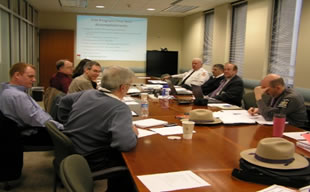
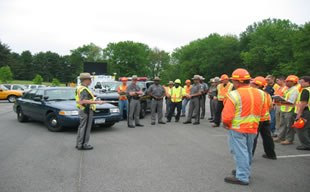
Photo credits: (left) VHB, (right) NYSDOT
slide notes
At this point we present some of the major elements of a successful TIM program using New York State as the example.
One of the key actions in the implementation of the program was the formation of an executive level steering committee.
 slide 33
slide 33
Success Story
NYS TIM Program
- TIM Components
- An active statewide TIM task force.
- Model partnerships with the state police.
- A statewide service patrol.
- TMCs operational for 24 hours and 7 days a week in most regions.
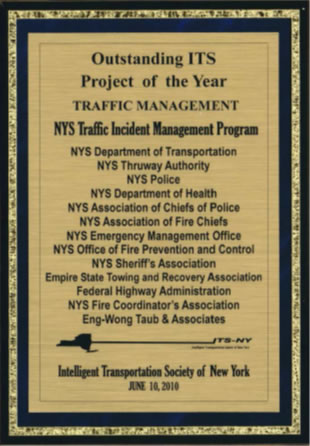
Photo credit: VHB
slide notes
This summarizes more of the elements of the New York State statewide TIM program.
 slide 34
slide 34
Implementation Strategies and Action Plan
slide notes
This is a transition slide, may wish to say “this section discusses desired implementation strategies and presents an action plan” and then advance to the detailed slides.
 slide 35
slide 35
Steps for Establishing a TIM Program
- Identify Stakeholders
- Define the Problem
- Set Goals and
- Objectives
- Develop Alternatives
- Evaluate and Select Alternatives
- Implement Alternatives
- Reevaluate Alternatives
- Refine the System
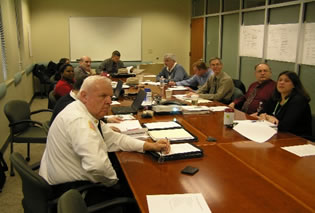
Photo credit: VHB
slide notes
“Speak to” the next 3 slides using the bullets – it may not be necessary to discuss each one.
Note: A slide has been added at the end to summarize executive management’s key roles.
 slide 36
slide 36
Implementation Strategies
- Regular TIM meetings
- Multidisciplinary
- training
- Tracking of performance
- goals
- Develop and promote TIM procedures and policies
- Coordinate the available resources
- Strategic collaboration

Photo credit: FHWA
slide notes
“Speak to” the next 3 slides using the bullets – it may not be necessary to discuss each one.
Note: A slide has been added at the end to summarize executive management’s key roles.
 slide 37
slide 37
Action Plan
- Establish and formalize a TIM program with the following components:
- Incident management policies and plans
- Interagency relationships
- Organizational structure
- Staffing and training
- Performance goals
- Reporting channels
- Budget
slide notes
“Speak to” the slide using the bullets – it may not be necessary to discuss each one.
Note: A slide has been added at the end to summarize executive management’s key roles.
 slide 38
slide 38
Key Roles for Executive Management
- Make TIM a Core Program
- Provide leadership at all levels
- Support adequate resources (staff & funding)
- Organize the agency for an effective program
- Require program support at all levels of the organization
slide notes
“Speak to” this slides using the bullets – it may not be necessary to discuss each one.
This slide summarizes executive management’s key roles.
 slide 39
slide 39
Key Roles for Executive Management
- Engage executives from other agencies
- Participate in statewide committees and conferences
- Work to remove jurisdictional barriers
- Support needed policy development and training
slide notes
“Speak to” this slides using the bullets – it may not be necessary to discuss each one.
This slide summarizes executive management’s key roles.
 slide 48
slide 48
Thank You!
For national level questions, please contact: